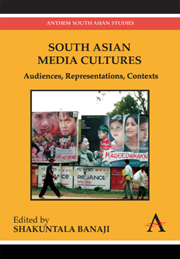Book contents
- Frontmatter
- Contents
- List of Illustrations
- 1 Introduction
- Part One Elaborating Audiences: Meaning, Use and Social Context
- 2 Talking Back to ‘Bollywood’: Hindi Commercial Cinema in North-East India
- 3 ‘Adverts Make Me Want to Break the Television’: Indian Children and their Audiovisual Media Environment in Three Contrasting Locations
- 4 Urdu for Image: Understanding Bangladeshi Cinema through its Theatres
- 5 Musical Media and Cosmopolitanisms in Nepal's Popular Music, 1950–2006
- Part Two Telling Texts: Media Discourse, Identity and Politics
- Part Three Alternative Producers: The Articulation of (New) Media, Politics and Civic Participation
- List of Contributors
2 - Talking Back to ‘Bollywood’: Hindi Commercial Cinema in North-East India
from Part One - Elaborating Audiences: Meaning, Use and Social Context
Published online by Cambridge University Press: 05 March 2012
- Frontmatter
- Contents
- List of Illustrations
- 1 Introduction
- Part One Elaborating Audiences: Meaning, Use and Social Context
- 2 Talking Back to ‘Bollywood’: Hindi Commercial Cinema in North-East India
- 3 ‘Adverts Make Me Want to Break the Television’: Indian Children and their Audiovisual Media Environment in Three Contrasting Locations
- 4 Urdu for Image: Understanding Bangladeshi Cinema through its Theatres
- 5 Musical Media and Cosmopolitanisms in Nepal's Popular Music, 1950–2006
- Part Two Telling Texts: Media Discourse, Identity and Politics
- Part Three Alternative Producers: The Articulation of (New) Media, Politics and Civic Participation
- List of Contributors
Summary
Hindi Commercial Cinema and Popular Culture in North-East India
This chapter looks at the impact of the Hindi commercial film industry on ‘peripheral’ cultures in India. The Indian film industry – which comprises both ‘Bollywood’ (as the Hindi commercial film industry is becoming known) and regional film industries particularly in south India – is one of the largest film industries in the world. The industry puts out over a thousand films every year and a staggering audience of fourteen million people watch an Indian film every day (Bose 2006). Bollywood exerts considerable cultural influence in India as it often both mirrors and mocks Indian society. The reception of Bollywood (and of mainstream Indian popular culture which is dominated by the former) among peripheral and under represented cultures in North-East India, is the subject of this chapter. The chapter looks at the love-hate relationship towards Hindi popular and film culture that people in this region have. North-East India is home to diverse ethnic groups, who have historically never felt a part of mainstream India. The region is caught up in several political conflicts with the Indian state. Most of these movements claim political autonomy, arguing that the distinct identities of people in the region entitle them to self-government and cultural freedom. Today, as satellite channels have proliferated in the region, Hindi commercial cinema is becoming extremely popular despite the fact that several political groups have banned such films.
- Type
- Chapter
- Information
- South Asian Media CulturesAudiences, Representations, Contexts, pp. 29 - 50Publisher: Anthem PressPrint publication year: 2010



